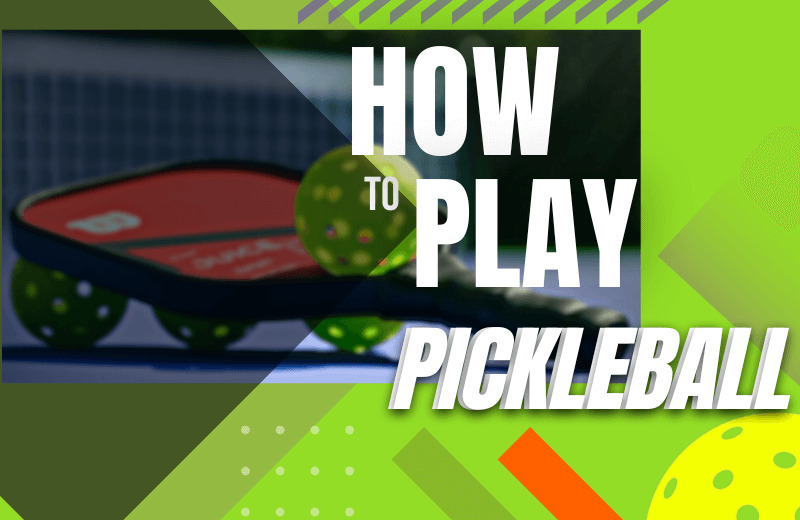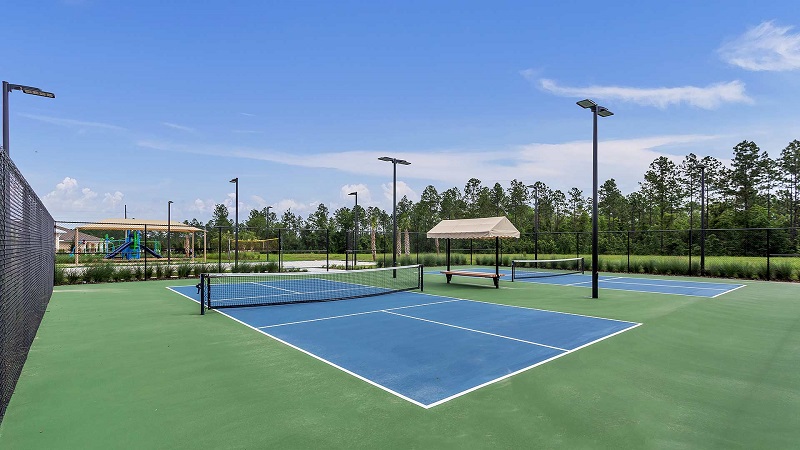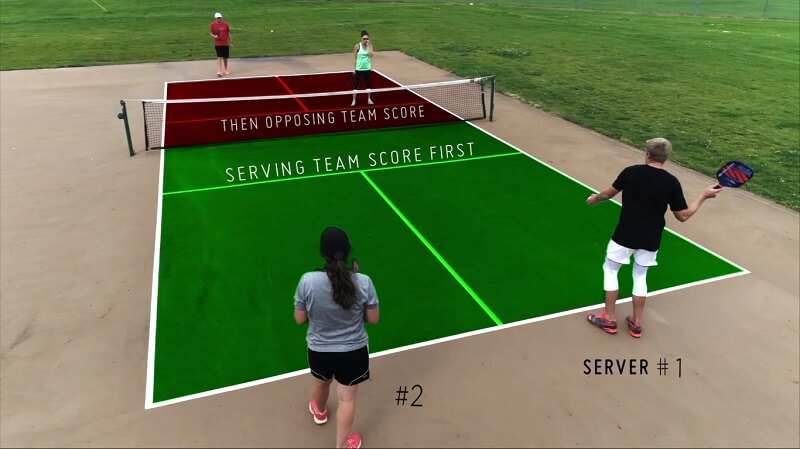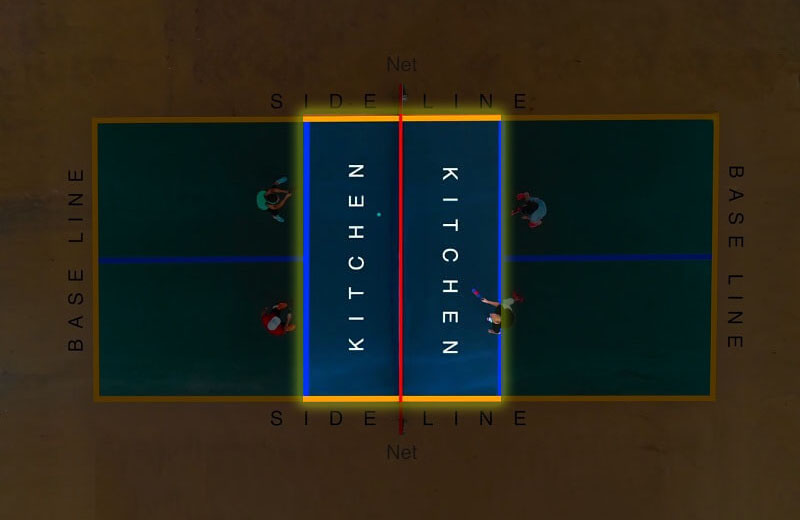Where is Pickleball Played?
Pickleball is a fun and easy game that can be played almost everywhere. From professional pickleball courts to old tennis courts and even your backyard, playing pickleball is a feat that can be achieved everywhere.
- Read more: “8 Easy Ways To Find Pickleball Courts Near Me 2023″
Types of Pickleball Courts
Pickleball can be set up anywhere as long as there is enough space according to the official Pickleball Court Dimensions. We’ve listed the multiple types of Pickleball courts and all the various options you have:
- Official Indoor and Outdoors courts: You can pay for a membership and get access to your local purpose-made pickleball court. The equipment for the indoor vs outdoor pickleballs courts differs slightly. We would recommend paying for a membership if professional pickleball play is something you have in mind
- Convert an old tennis/badminton court: If you don’t have access to a purpose-built court, you can simply convert a tennis or badminton court no longer in use, into a pickleball one. As long as you are aware of the official dimensions, you can paint over the old court, draw the lines and set up the net to create your DIY pickleball court.
- Turn your backyard into a court: Pickleball is a flexible game that can be played on almost all surfaces, including grass. Not everyone can afford the expensive membership fees, so some pickleball wikis do consider backyard courts a viable last resort. Set up the court with official dimensions and you’re good to go.
- Temporary courts: You can use empty parking lots, driveways, or empty streets in your neighborhood and convert them into temporary courts for practice. Use tape or other semi-permanent material like chalk to define the lines and start practicing.
How is Pickleball Played
“How do you play pickleball?” is the essential question and we’ve got you covered.
Service
Like all racket games, pickleball starts with a serve. To start the game the server must stand behind the baseline to make an underhand serve from the right-hand side of the court diagonally across to the other side. This means striking the pickleball so it lands below waist level.
After the serve, the opposing team must let the ball bounce once before hitting it. The serving team will also let the ball bounce before the first shot. This is known as the double bounce rule.
Fun fact! In a singles game, the serve is made from the right service court when the score is even and from the left service court when the score is odd.
Playing as Singles and Doubles
Pickleball matches can either be played as singles, with two players or as doubles with four players which makes 2 teams of 2.
In either case, each side of the court gets 2 serves. In the case of singles, each player gets 2 serves. In doubles, each team gets 2 serves, with both players being allotted one serve each. They are appointed as server #1 and server #2 to help the opponents keep track of the score.
Scoring a Point
Pickleball is unique when it comes to scoring a point. A team can only score a point when serving. The receiving team can only win a serve, not a point if the serving team commits a fault. The serving team must win the rally to score a point. This is done if the receiving team commits a fault or is unable to return their shot
The rally continues until either the serving or receiving team makes a fault, or misses the ball. If the serving team makes a fault, they only lose their serve. However, if the receiving team commits a fault, a point is allotted to the serving team.
Some common faults include the ball hitting the net, the ball landing out of the confined space, and players hitting a volley shot in the Non-volley zone
Keeping Score
The scoring of pickleball can get slightly confusing for beginners. Fret not because we are here to help you break it down.
Traditionally, a game is played until either side reaches 11 points, leading with a minimum of 2 points. However, the score may be set higher, to 15 or 21 e.g., in professional matches, or lower when pickleball is being played casually.
- Read more: “How Long Does A Pickleball Game Last?”
The two-digit singles match scoring system is easy enough to understand. The score is called out as server score-receiver score e.g. 6-8, with 6 being the server’s score and 8 being the receiver’s. The three-digit doubles score, however, can confuse beginners. Let’s break it down with an example of the score being 8-6-1;
The first digit (8) shows the serving team’s score. The second digit (6) indicates the receiving team’s score. The last digit (1) represents the server number since each team gets two serves in a doubles pickleball match, one for each team member. Thus 6-8-2 represents the serving team’s score, the receiving team’s score, and the server number respectively.
Now that you’ve gone through the basics of scorekeeping and what score you play to in pickleball, we hope you’ll enter your next match with a better understanding.
Rules to Keep in Mind
Like every game out there, pickleball has its own rules and regulations. These are made by the USA Pickleball Association (USAPA), and the International Federation of Pickleball (IFP.).
Learning so many new rules can intimidate players. We would recommend going through the entire rulebook once to ensure you play safe, but here are the 5 basic rules to get you started:
- The ball must stay inbounds: If it goes out of the defined boundary, the opposing team either scores a point or a serve
- Service Rules: The ball must be served diagonally across the court from behind the baseline. This should be done in an underhand serve and must land outside the NVZ on the other side. Failure to comply with these rules means the serve is lost
- No volleys in the non-volley zone: To hit a volley means to make the shot before the ball has the chance to bounce. If a player hits a volley shot in the NVZ, it’s considered a fault, even if it was only their feet touching the NVZ line.
- Double Bounce Rule: After a serve, both the receiving and the serving team must let it bounce once each before returning it.
- Net Rules: If the ball hits the net or any permanent court object, it is considered a fault, and the serve/point is lost.
We know so many rules can seem overwhelming, so start with one, keep it in mind during your next session, and move to the next. This way you’ll have the rules on the tips of your fingers in no time!
Conclusion
All in all, pickleball is a fairly interesting game that is well-loved because of its flexibility and accessibility. You can set up a court anywhere and with this guide, master the basics in no time.
Let us know whether you heard about the game from a friend or decided to Google what pickleball is, in the comments below.
Related Articles:
- Pickleball For Beginners: 6 Crucial Things To Get Started
- How To Choose A Pickleball Paddle: A Paddle Guide
- Pickleball Paddle Dimensions: Paddle Size Guide
- Pickleball Terms: Definitions To Get Familiar with Pickleball





